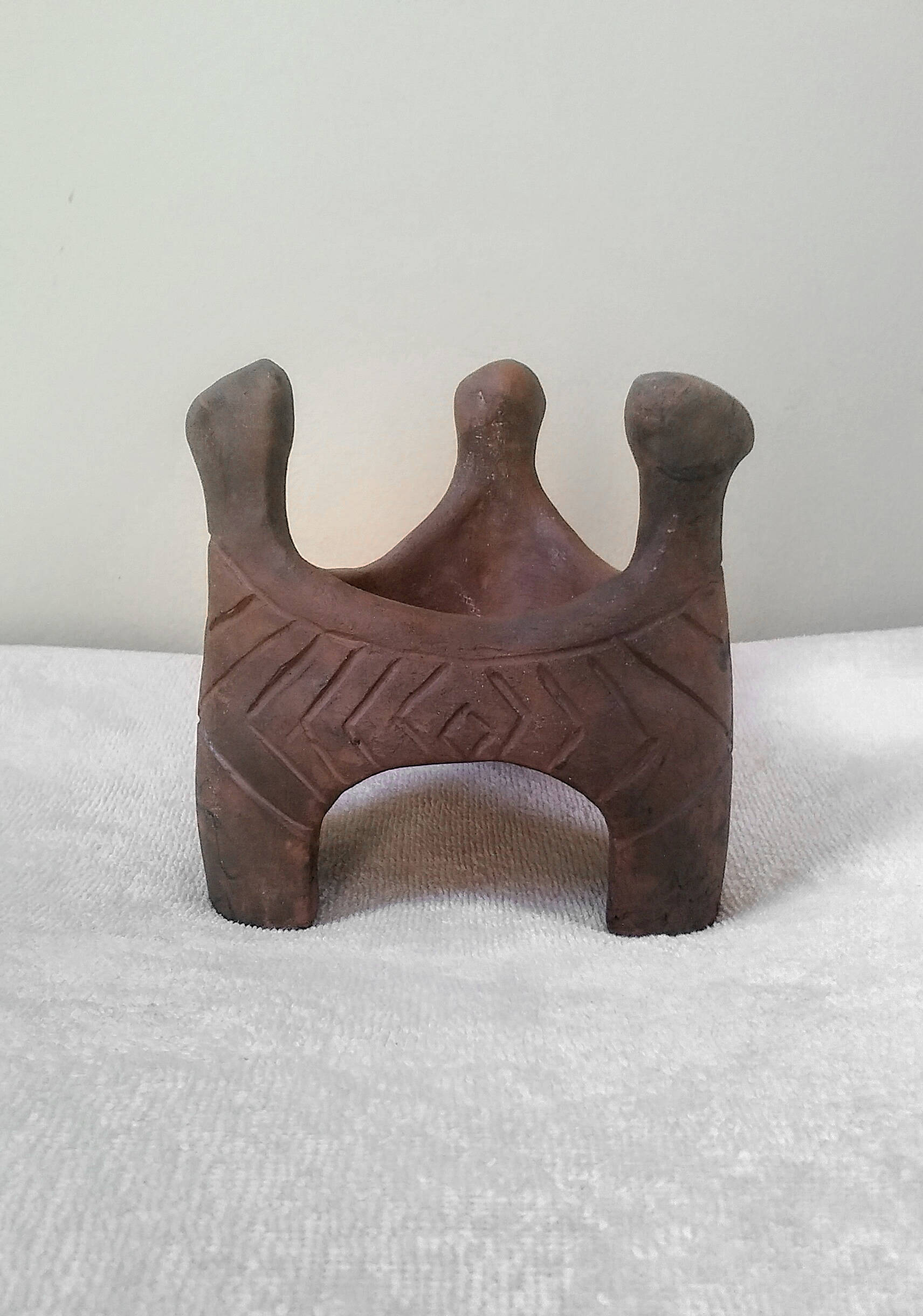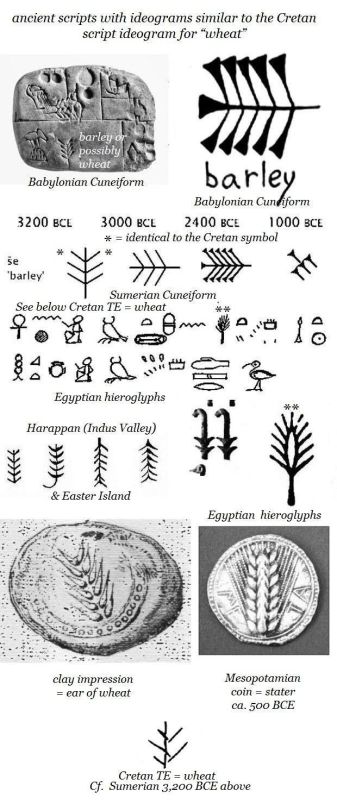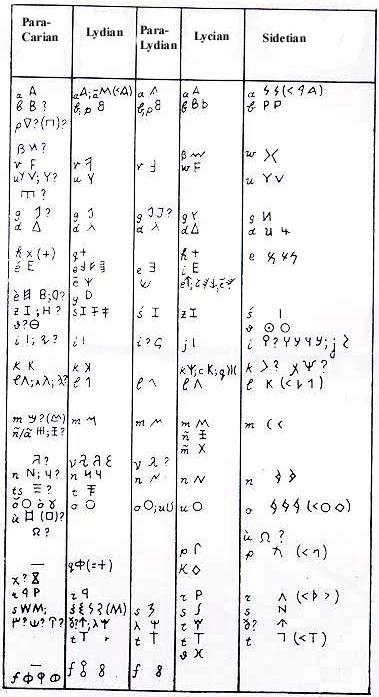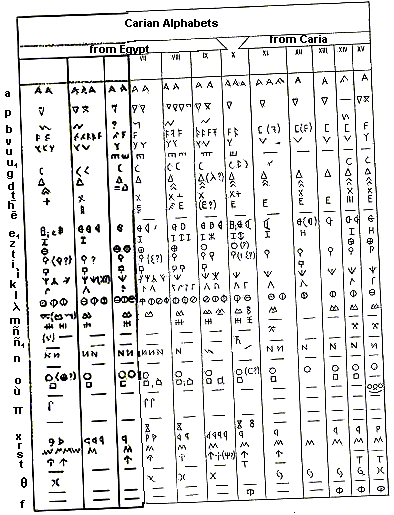Careful/ Attention ! This post is not a decipherment or reading of any actual written content of Tartaria tablets. Given that the signs do not belong to a known and single writing system but from several, the page has a purely didactic character. It has the role of trying and testing different writings, in the idea that the tablets would have used one of them. The signs on the tablets belong to several writing systems over a long period of time and which have been used in different geographical areas. In none of the trials did the signs fall into a single type of writing, there always remained signs that came from other writings (or as coming from the unknown). Most of the signs come from the Sumerian proto-cuneiform signs. The signs in the upper half of the round tablet seem to come from archaic Greek writing. This “collection” of signs seems to be the fruit of one’s rich imagination. As A. Falkenstein and A. A. Vaiman found, (this is also my firm opinion) the author was not a scribe, he had only vague notions of writing in general, and it is not known what he intended or he was after. There are many elements of inconsistency as well as others that take the tablets out of the usual patterns and norms of honest logic, writing and intentions. =====
SCIENTISTS ALLREADY CORRECTLY NOTICED (ME ALSO FULLY AGREE)THAT THE CLOSEST WRITING SYSTEM TO THE SIGNS PRESENT ON TARTARIA TABLETS IS SUMERIAN PROTO-CUNEIFORM. THE PURPOSE OF PRESENT APPROACH IS ONLY TO TEST HOW CLOSE WOULD BE THE ROUND TARTARIA TABLET TO AEGEAN WRITING.
TARTARIA ROUND TABLET
CRETAN HIEROGLYFIC LINEAR A/B APPROACH
Image, from https://cogniarchae.com/2015/10/29/tartaria-tablets-connection-between-vinca-and-proto-linear-b-script/

Acknowledgement
I am studing these Tartaria tablets from more than 10 years. Soon after seeing their pictures, I was attracted bewitched/enchanted by the apparent close appearance of signs (especially the upper half of the round tablet) to those of archaic greek. (archaic eta=Heta; rho,etc.) First of all, it seems that ON ALL TABLETS THERE ARE A AGGLOMERATION OF DIFFERENT TYPE OF SIGNS (PICTOGRAPHIC, IDEOGRAMS/SYLLABOGRAMS AND POSSIBLE LETTERS).
But there are some questions wich wait answers:
– Nobody could explain an such early appearance of D-shape signs. To my knowledge, they appeared first in Europe in Linear B as representing volume measures units and later in archaic Greek. I had difficulties also with the bow-arrow and “>>” signs.
I SEARCHED IN WICH WRITING MOST OF THE SIGNS ARE TO BE FOUND – Cretan hierogliphic show an old influence from sumerian and Anatolian writings. For signs/icons placed right-downward quarter not found easy matching. They seem to be complex ideograms or kind of ligatured signs. – For carian most of the signs were found. Highest average ! 80%. But pitty, not all signs!. Dificulty arouse not because carian used different signs-shapes-letterss-readings in different ages and places, despite their very greek origin. Not even talk about the carian language wich is partly understood only by 1-2 men (e.g. Ignacio Adiego) out of entire world. There are in total 25 carian alphabets. So the writing and the language each taken apart are difficult and that both combined give a GREAT MESS. – Other European writings as italic-venetic, iberian ond others from Europe has shown an phenomenom like frome some phoenician source letters dispersed all-over Mediterranean area. Table, from Alphabetos de ayer y de hoy http://proel.org/index.php?pagina=alfabetos :

No one writing system could match found/read entirely.
Don’t believe, this happened much easy when used the proto-cuneiform sumerian library of signs.
It seems that sumerians allready wrote novels before Aegeans passed from Cretan hieroglyphic to linear A> linear B.
There is a span close to 1.000 years (700), when they used writing (3.200 BC)before Aegean/Europe (2.500BC) begun.(3.200 BC sumerian proto-cuneiform and 2500 Cretan hieroglyphic and Linear A). This folowing picture is of hand-made by me replica.
 http://aplaceofbrightness.blogspot.ro/2008/11/moonlight-in-romania-tartaria-tablets_21.html Folowing image: https://encrypted-tbn0.gstatic.com/images?q=tbn:ANd9GcTCGJ5DXc0fsaWc67tfd57-J-2TRy0Mwu9JqqG8dK242WM2a4_z
http://aplaceofbrightness.blogspot.ro/2008/11/moonlight-in-romania-tartaria-tablets_21.html Folowing image: https://encrypted-tbn0.gstatic.com/images?q=tbn:ANd9GcTCGJ5DXc0fsaWc67tfd57-J-2TRy0Mwu9JqqG8dK242WM2a4_z
1-st QUADRANT ( downward half- on the right )
See the red sign downward-right quarter From http://cristianluchian.co.uk/wp-content/uploads/2014/04/cristian_luchian_tartaria_tablets.jpg

This shape is conducting me (and not a single opinion)to the idea of kind of portable altar with flames on upper side (as this real portable-altar from Vinca Culture) Image from etsy.com 
The sign in a way is close to cretan hieroglyphic sign DE, ( turned upside-down) From http://www.kairatos.com.gr/linear1.htm

Table,from http://www.kairatos.com.gr/linear1.htm

But much close is linear A(also upside-down),sign AB 45
Note.Overall shape of the tablet (cross in circle) is above linear A shape AB77.
But much close to before discussed sign is the linear A “DE” sign
in normal position and in other occurencies turned upside-down
But in the same position also DE in LINEAR B
https://image.slidesharecdn.com/mycenaeans-1229034501455786-1/95/mycenaeans-21-728.jpg?cb=1229006262 From http://www.crystalinks.com/linearb.html

From Σάββατο, 8 Νοεμβρίου 2014 Systematic analysis reveals relationship of the alphabet with other Mediterranean scripts Cosmas Theodorides http://studialphabetica.blogspot.com/ See Vinca sign E !

FINAL READING:”DE“? E?, or COMPLEX IDEOGRAM for ESCHARA/ALTAR (!incense burner !) ——————————————————- On the right, https://1.bp.blogspot.com/_DT_WSLrf76g/SSNCmagewzI/AAAAAAAAADI/9q2aaDwIMzs/s1600-h/SEgrid.JPG From http://aplaceofbrightness.blogspot.com/2008/11/moonlight-in-romania-tartaria-tablets_21.html

From THE MYCENAEAN TREE AND PILLAR CULT AND ITS MEDITERRANEAN RELATIONS. A.EVANS http://www.archaeologicalresource.com/Books_and_Articles/Tree_and_Pillar_Cult_Medit_Evans_1901/Tree_and_Pillar_Cult-Mediterranean_Evans.html http://www.archaeologicalresource.com/Books_and_Articles/Tree_and_Pillar_Cult_Medit_Evans_1901/images/image58.png

.Fig. 54. – Symbols derived from the Egyptian Ankh. 1. The Ankh. 2. Two-armed Egyptian Form. 3 and 4. Hittite Types. 5. From Mycenaean Ring. 6. On Carthaginian Stele.
Close to linear A, AB 80 “E”,or “RI”
See E signs shape, especially that one down-middle-one
Or even linear A, “MA” (having included a horizontal ligature?)
http://2.bp.blogspot.com/_a_qIRGD3pJ0/S_qxpdDgI3I/AAAAAAAAAbA/QcXKTDMye5A/s1600/Linear-A-base.jpg From John Jounger http://people.ku.edu/~jyounger/LinearA/ ![]() *80 MA, perhaps a logogram on HT 146.3, 110b.2, 5 (cf. Linear B ma-ra-tu-wo)
*80 MA, perhaps a logogram on HT 146.3, 110b.2, 5 (cf. Linear B ma-ra-tu-wo)
The sign has appearance of a female deity:
Minoan snake goddess figurines – Revolvy
https://www.revolvy.com/…/index.php?s=Minoan%20snake%20goddess%20figurines…
The snake goddess’s Minoan name may be related with A-sa-sa-ra, a possible interpretation of inscriptions found in Linear A texts. Although Linear A is not yet deciphered, Palmer relates tentatively the inscription a-sa-sa-ra-me which seems to have accompanied goddesses, with the Hittite išhaššara, which means …
http://firstlegend.info/thevenuscult.html
Syrio-Hittite Venus 18-1000 BC Central and southwest Anatolia northern Syria
The goddess Astarte is much like the contemporary Venus we see on Cyprus. Large holes apparently for ring decoration (referred to as being “pegged”), palm sized with stubby arms are a common style among other cultures too. The pinched face is found on the stubby armed figurines as well as the pillar shaped statuettes.
TANIT Image from https://www.elinritter.com/tanit-the-goddess-of-ibiza/ 
A-SA-SA-RA Image, from https://feminismandreligion.com/2014/11/10/has-the-phaistos-disk-been-cracked-by-carol-p-christ/ 
From DOCUMENTS IN MINOAN LUWIAN, SEMITIC, AND PELASGIAN FRED C. WOUDHUIZEN file:///C:/Users/User/Downloads/Documents_in_Minoan_Luwian_Semitic_and_P.pdf
“From these data, it may be deduced that the most important deity, with (if we include the abbreviated instances) 17 occurrences in sum, is Asasara, 3 who has been convincingly identified with the Semitic mother-goddess Asherat or Asherah. The most characteristic symbol of this goddess is the double axe, which in writing functions for the expression of the initial vowel of her name, a (E36 or CHIC 042), and as such may be used on its own to refer to her in abbreviation.4 On the south pillar of the pillar crypt in Malia (see Fig. 75), the symbol of Asherah occurs twice in combination with that of a star with either six or eight points. Now, against the backdrop of the identification of the main goddess as Asherah, it stands to reason that we are dealing here with the symbol of the daughter of this mothergoddess, Ashtarte, whose name originates from PIE *h2stḗr- “star”, but we can as yet not be certain of this as we lack an instance of this divine name written out in full. However, this same shortcoming does not affect the symbol of the storm-god in the form of a trident on the north pillar of this same pillar crypt at Malia, because the hieroglyphic inscriptions from the palace of Malia and Quartier Mu at the same site positively allow for the latter’s identification as Luwian Tarkhu(nt). In these texts, namely, the name of Tarkhunt occurs in the form of the goat’s head sign TARKU (E65 or CHIC016) as much as 11 times, and is in frequency outmatched only by that of Asherah referred to in abbreviation by the double axe as much as 12 times (note that in two instances, # 098 and # 112, both deities occur together in the same text). On the other hand, it should be realized that the storm-god may also be referred to by Semitic forms of address like Haddu or Baªal, as it happens to be the case in the text of the discus from Phaistos (# 333), and the altar stone from Malia (# 328) which according to its legend ultimately originates from Skheria (= Hagia Triada) also in the Mesara. In reality, this change from a Luwian to a Semitic form of address for the storm-god may not have been as fundamental for the Minoans as it might seem to us at first sight, as on the A-side of the discus of Phaistos the storm-god is referred to in his Luwian form Tarkh˙unt, again, by his symbol the trident or bolt of lightning
The right sign is close to sign AB 80, linear A “E”( or RI) RIGHT SIGN, LINEAR A “E” or AN ASTRAL DEITY (as ASASARA) ———————————————–
LEFT RIGHT
Hier.DE lin.A E?
lin.A AB45 lin.A AB80
lin.A DE lin.A RI, lin.A MA
Compared with linear B,

Also,not much difference:Lin.B:
LEFT RIGHT E E DE E
Reading: De ; Ri/E ; EDE:”EAT“ /gr. edo:”(I) eat” …………..ede, the same as in quadrant with signs HD:(h)eDe (P.I.E.:”hED“)
Note
The signs seem to be independent icons, not to be read both as a word
( both signs ,DeRI/RiDe EDE DE-MA ?)
EDE:”gr.here,this one,NOW / lat.2-nd imp. “lat.EAT,feed!/Dispatch !”(gr.edo:I eat)
FINAL READING OF THE SIGN SITUATE ON THE RIGHT: “E”/”MA” ? or complex ideogram of an astral deity as ASASARA
FINAL READING FOR BOTH SIGNS:
It seems that there are or words, (E-DE/DE-MA) but rather ideograms/logograms: altar.incense burner <&> fem.astral deity Asasara-like
QUADRANT 2
From https://2.bp.blogspot.com/_DT_WSLrf76g/SSNCIVGnLGI/AAAAAAAAAC4/3y1gwcGR4os/s1600/NEgrid.JPG

Upper sign,(encircled-one) +++++ ! There is NO SUCH SIGN 5-teeth comb in Aegean writings ! FromJOHN JOUNGER’s blog, http://people.ku.edu/~jyounger/LinearA/  *171, logogram on ZA 6a with agricultural commodities (perhaps also on THE Zb 5); in Linear B, it occurs with livestock (fodder? TH nodules)
*171, logogram on ZA 6a with agricultural commodities (perhaps also on THE Zb 5); in Linear B, it occurs with livestock (fodder? TH nodules)
Sign +++++
Cretan Te,”wheat”
https://i.pinimg.com/736x/95/30/e5/9530e511673bbc954e8153dd163f8862.jpg Cretan hieroglyphs, From https://linearbknossosmycenae.com/tag/ideograms/
 From From https://linearbknossosmycenae.com/ta g/ideograms/
From From https://linearbknossosmycenae.com/ta g/ideograms/

https://encrypted-tbn0.gstatic.com/images?q=tbn:ANd9GcRykURVevP7C91htJQXSWtUoIKlv_VE7Zk8RacOILleQApR07vw https://commons.wikimedia.org/wiki/File:Linear_B_Syllable_B004_TE.svg ![]() John Jounger http://people.ku.edu/~jyounger/LinearA/
John Jounger http://people.ku.edu/~jyounger/LinearA/ ![]() *171, “logogram on ZA 6a with agricultural commodities (perhaps also on THE Zb 5); in Linear B, it occurs with livestock (fodder? TH nodules)” FINAL READING: TE-TE ? what would be tete? or sign like Aegean one in some sort of local script meaning also cereal? CEREALS,WHEAT
*171, “logogram on ZA 6a with agricultural commodities (perhaps also on THE Zb 5); in Linear B, it occurs with livestock (fodder? TH nodules)” FINAL READING: TE-TE ? what would be tete? or sign like Aegean one in some sort of local script meaning also cereal? CEREALS,WHEAT
======================================= Down, in a row : D D o o (or D D o c ?) As a long row of researchers supposed to have in those 4 signs the Moon phases, this could be taken in account, so representing a full Month with its main phases. Otherwise, I do not know of no single instance, in any known writing, other yhan Jiahu script, where the D-shape to represent the moon. Only as C-shape: IURII MOSENKIS file:///C:/Users/User/Downloads/HELLENIC_ORIGIN_OF_EUROPE_Formation_of_t.pdf‘Sign *034 “C“has been suggested to represent MNA (or, if a disyllabic value can be
accepted, MINA), based on its resemblance to the crescent moon (Pope and Raison 1978, 28;Packard 1974, 107; Furumark 1956, 24). And while this idea has not received wide-spread agreement, it may be correct. ————————————————— The D-shape sign is missing in all Aegean before-alphabetic writings ! The folowing is a try, “in place of”/emergency solution. No credit for my part. : D D :Two months? ; From http://minoablog.blogspot.com/2012/04/exploring-cretan-numeral-system.html

2 measures of grain, 0,8 litre/each? folowed by number 200 ! nonsense ! From RICHARD VALLANCE blog, https://linearbknossosmycenae.com/2015/02/19/mycenaean-linear-b-units-of-measurement-liquid-dry-weight-click-to-enlarge/ https://linearbknossosmycenae.com/2015/02/19/mycenaean-linear-b-units-of-measurement-liquid-dry-weight-click-to-enlarge/

————————————————————————————- Sign “o” Cretan hieroglyphic http://mnamon.sns.it/index.php?page=Simboli&id=35&lang=en sign 073 A TABLE OF SIMILARITIES https://www.teicrete.gr/daidalika/documents/…/signary.pdf.. 073 qe (kwe), Cretan Hieroglyphic Grids http://www.people.ku.edu/~jyounger/Hiero/Hgrids.html .. 073 KU3 From http://people.ku.edu/~jyounger/LinearA/
 *309, only TY 2 in three variations *309a
*309, only TY 2 in three variations *309a  *309b
*309b – *309c –
– *309c – ———————————————————————
———————————————————————
Siggn “C” From http://people.ku.edu/~jyounger/LinearA/ Sign *034  has been suggested by several scholars to represent MNA (or, if a disyllabic value can be accepted, MINA), based on its resemblance to the crescent moon (Pope and Raison 1978, 28; Packard 1974, 107; Furumark 1956, 24).
has been suggested by several scholars to represent MNA (or, if a disyllabic value can be accepted, MINA), based on its resemblance to the crescent moon (Pope and Raison 1978, 28; Packard 1974, 107; Furumark 1956, 24).
Linear A , sign A309a http://mnamon.sns.it/index.php?page=Simboli&id=19&lang=en From John JOUNGER http://people.ku.edu/~jyounger/LinearA/
sign A309 , only TY 2 in three variations *309a
, only TY 2 in three variations *309a ![]() and…. (me:nothing about meaning)
and…. (me:nothing about meaning)
“oo“-signs: mycenaean”100 ;-100” so 200 ?
D D o o : two months + 200 ? D=meno
From https://www.academia.edu/15310428/Linear_B_Lexicon_by_Chris_Tselentis_Greece_
me-no menos meinos …………men>menas mein>meinas
month (men= month/moon/anAnatolian deity)
|
|||
| Definition | |||
|
|||
https://glosbe.com/el/en/%CE%BC%CE%B1%CE%B9%CE%BD%CF%8C%CE%BC%CE%B5%CE%BD%CE%BF%CF%82 μαινόμενος livid{ adjective }very angry, furious
D D o o MOON/remain,abidex2=plural egg/oo,oio/originate
D D oo MENO MENoio menoio=menoio(s) “MINoan(s)”
(The sumerian proto-cuneiform signs and archaic greek letters are fitting much easier/very easy) NOTE THAT: – ALLMOST ALL OF EARLIER WORLD WRITINGS WERE ECONOMICAL ACCOUNTS – IN 3 SOME OF THE FIRST WRITINGS, D-SIGNS WAS FOR : 1.BEVELED BOWL, DISH.DAYLY (bread,cereal)RATIO,BREAD in sumerian proto-cuneiform 2. “LOAF OF BREAD“,”T” in Egypt 3. VOLUME MEASURE IN LINEAR B
Beveled-rim bowls (left) used for the disbursement of rations … https://www.researchgate.net/…/Beveled-rim-bowls-left-used-for-the-disbursement-of-rat… “Beveled-rim bowls (left) used for the disbursement of rations represented by the sign GAR (middle, left column) which could be used to designate a ration of a …”
FINAL READING: 2 VOLUME UNITS ; 100 100 “200 DOUBLE-MEASURES“? ———————————————————
QUADRANT 3


See archaic Heta-like sign No.6 “NU”?

Linear A sign “BE”/”PE”?? No! https://cogniarchae.com/2015/10/29/tartaria-tablets-connection-between-vinca-and-proto-linear-b-script/
(but exact shape of linear B sign PA3) From John Jounger http://people.ku.edu/~jyounger/LinearA/ ![]() *56 (PA3), HT 9b.1, 132.2, 34.6
*56 (PA3), HT 9b.1, 132.2, 34.6
Indo-European and the Indo-Europeans – CLAS Users
users.clas.ufl.edu/drjdg/historical/pubs/IE.pdf
*peh2- ‘protect; feed’ (آHittite:ً pa-ah-sa(pahsa): protect, guards 3sg.Skt. pa-ti ‘protects’) : *peh2-trom / *peh2-dhlom … OPULENT (same root [*op-1] as Lat. opera ‘works’ etc.).
Reconstruction:Proto-Indo-European/peh₂- – Wiktionary
https://en.wiktionary.org/wiki/Reconstruction:Proto-Indo-European/peh₂-
to reconstruct *h₃ … Ancient Greek: πατέομαι (patéomai, “to eat”).
Folowing, the moon-like sign D-shaped ! THERE IS NO D-shaped sign IN AEGEAN WRITINGS EXCEPT for VOLUME UNIT !
I try to be read Mi-Ni,Me-No,ME-NA ( the MOON )
A TABLE OF SIMILARITIES
https://www.teicrete.gr/daidalika/documents/phaistos_disk/signary.pdf .? (as in me-na. . the moon), or qim (kwi, as in qi-si-pe- e,
https://en.wiktionary.org/wiki/%CE%BC%CE%AD%CE%BD%CE%BF%CF%82 Proto-Hellenic *ménos, from Proto-Indo-European *ménos (“mind”
Pe-MeNa ?? PEMEN >> gr.phemen see https://www.verbix.com/webverbix/go.php?D1=206&T1=%CF%86%CE%B7%CE%BC%CE%AF
gr.Phemi> phamen, phaimen
If we have linear B “PA3” then PA-MEN >gr.PHAMEN
φημί • (phēmí) https://en.wiktionary.org/wiki/%CF%86%CE%B7%CE%BC%CE%AF
1.I speak, say.
1.I think
2.(of an author) I write
3.(φησί or ἔφη used when quoting, sometimes after another verb of saying) quotations ▼
2.I say yes, agree, affirm, assert
1.(with οὐ) I say no, deny, refuse quotations ▼
2.(φημί or οὕτως φημί as interjection) yes, I would say so
https://en.wiktionary.org/wiki/Reconstruction:Proto-Indo-European/peh₂-
Semantic shift from “protector” towards “shepherd, herder” can be seen in many branches, signifying the importance of herding. Unusual is the o-grade root in Greek ποιμήν (poimḗn, “shepherd, herdsman”),
https://en.wiktionary.org/wiki/%CF%80%CE%BF%CE%B9%CE%BC%CE%AE%CE%BD
Mycenaean Greek (po-me), Latin pascō (“put to graze”), pāstor (“shepherd”), Sanskrit पाति (pā́ti),
——————————————–
My note
Gr.hed>ed (eat) Pa(teomai)(eat)
In PIE ed :to bite=to eat used same root ED related also with teeth (edontos)
ed-, edi- – Word Information
wordinfo.info/unit/4532/ip:1/il:E
Latin: edere, “to bite, to eat; eating, eatable; consume” … Etymology: from Indo-European ed-, “eat” which produced the basic word for “eat” in many European languages. From Greek edein and Latin edere, “to eat”. eatable (adjective), more eatable, most eatable. Referring to something that is safe toeat: People have to be …
Note also:
Sumerian HEDU:”ornament” (En-hedu-ana),and
use of theses – ANU Repository
Click to access 02Whole_Lee.pdf
b The Greek words ‘hedea’. (‘pleasant-things’} and ‘hedonai’ (‘pleasures’) can denote,. 61 firstly, things or events external to the agent, secondly,. 62 the agent’s bodily sensations, and, thirdly, certain. 61 In Homer, the word ‘hedu’ seems to function in much the same way as ‘gluku’-z’Sweet’), ..
Wich come to kid <=>gr./lat.:hed,hedus= sweet FromANISTORITON Journal of History, Archaeology, ArtHistory: Viewpoints http://www.a nistor.gr/english/enback/v053.htm One of the faces reads: Pa–me-ni po-lo 100 The foals (polo(i)) for this year (pameni has the dative ending, but cf. Greek pammenos) Please also note that the …
signs PA Moon > PA–MENI, PAMMENOS :”ALL MONTHs=(this) YEAR !!
https://journals.linguisticsociety.org/elanguage/pragmatics/article/download/541/541-873-1-PB.pdfCYPRIOT: How’s it going? – Pos pai; Note Anatolian/hittite has pa/pai :”give”
From https://archive.org/stream/dumezil-archaic-roman-religion-with-an-appendix-on-the-religion-of-the-etruscans-part-1/dumezil-archaic-roman-religion-with-an-appendix-on-the-religion-of-the-etruscans-part-1_djvu.txt This is the list of specialized entities whose names the flamen of Ceres recites when he sacrifices to that goddess and to Tellus ( quos inuocat pamen sacrum ceriale faciens Telluri et Cereri ).
See https://en.wiktionary.org/wiki/Reconstruction:Proto-Indo-European/peh%E2%82%82 ——————————————————————————————————————————–Signs: PA3 MOON ( PA;PAi )
Phaistos – Wikipedia https://en.wikipedia.org/wiki/Phaistos Phaistos also transliterated as Phaestos, Festos and Latin Phaestus, currently refers to a … After 1955 the place name, 𐀞𐀂𐀵, pa-i-to, interpreted as Phaistos (written in Mycenaean Greek), began to turn up in the Linear B tablets at Knossos,
MINOAN GREEK SOCIETY IN LINEAR A | iurii mosenkis – Academia.eduwww.academia.edu/…/MINOAN_GREEK_SOCIETY_IN_LI… … form of Greek ϕάϜος ‘light’ and means ‘the most lighted‘ (*φαϜ–ιστ-ος)1. … Four main palaces of Neopalatial period (Knossos, Phaistos, Mallia, and Kato …
PAi, as in PASIPFAI ; PA=PASI =”All” as in Pasitheoi “all gods” PA/PAi -(whatever Moon name) >? PA/PAi–Mi-Ni(mene,meinei) =”ALL/LIGHTED MOON” ?? P.S. One would think “all Moon” as Full Moon or as entire phases….
Picture, from https://encrypted-tbn0.gstatic.com/images?q=tbn:ANd9GcST4uXpqRcb9bf0G2R9ZPKbQSLtZ1tlyirRkwcMIRHtgcLLhyZ9UQ

Upper signs,left-one:” bow-arrow” THERE IS NO SUCH A SIGN IN AEGEAN WRITINGS !
Cretan Hieroglyphic A,U?; F Linear A SI? From http://people.ku.edu/~jyounger/LinearA/  *41 (SI), common / TU/ WA ? From http://people.ku.edu/~jyounger/LinearA/
*41 (SI), common / TU/ WA ? From http://people.ku.edu/~jyounger/LinearA/  *323, HT 96a.3,4 (??)
*323, HT 96a.3,4 (??)
Linear B,”ZO”?
NO-one match entirely,only “XE=Kse” from Cypriot syllabary
——————————————————————————– Next right sign “>>” THERE IS NO SUCH SIGN IN AEGEAN WRITINGS !
Match only “Pi” from cypriot syllabary, and linear A > :”TI” From http://people.ku.edu/~jyounger/LinearA/  *37 (TI), common My note:but is 90 deg. rotated! AT THE LIMIT/FORCED READING:”TI”
*37 (TI), common My note:but is 90 deg. rotated! AT THE LIMIT/FORCED READING:”TI”
—————————————————————————————- The last,downward it is linear A/B “PA” ——————————————————————— Now all 3 signs appear: WA TiTi
PA or Cypriot: Xe Pi
No mycenaean word xe-Pi,Pi-Pa or that kind. This could be the end of my attempt to read this tablet using Mycenaean signs (Cretan Hieroglyphic/Minoan Linear A/B signs). I cannot take some signs from one writing and other on the tablet from another syllabary or writing. This could be a good exemple for proving a writing not partain of one supposed writing system (syllabary in our case) Pro-argument to use (Mr.Vallance Janke, http://minoablog.blogspot.ro/2010/02/how-to-read-minoan-hieroglyphics.html ): “And I do agree with the theory that Hieroglyphic signs are ultimately ancestral to the Linear sytems. These include not only Linear A, but also its offsrings outside Crete, such as Linear B in mainland Greece, Cypro-Minoan and Linear C on Cyprus.”
But give another chance: Bow-Arrow:Cretan Hieroglyphic sign 048. From: http://chainimage.com/image/table-of-standardized-cretan-hieroglyphic-signs

Linear A Equivalents”
#048, 049 ‘archery’ signs (141) = AB41 / si (me):And >> sign cretan Hieroglyphic sign 018:”ru2(rjiu,lu) https://teicrete.gr/daidalika/documents/phaistos_disk/signary_July2017.pdf. So,
Si Ru/Rju
Pa/psa >> Pa:”All”
SIRU/SIRJU PA(siteoi-like?) SIRJU<?>SIRU or SIRJIU<?>SIRU(OSIRIS)? From the spiritual substratum of bronze age mediterranean & circum pontic …https://issuu.com/alaoupi/docs/-the_spiritual_substratum_of_bronze “Apart from Siru or Serio, who represents a ‘sun’ god, there is a lunar / solar trinity including Nopina (in later Greek = Nymph or Maiden), who”
From Sacred and the Profane, The – Dictionary definition of Sacred and the …https://www.encyclopedia.com/environment/encyclopedias…/sacred-and-profane “In general the synonyms in the Indo–European languages for what the metalanguages imply with their contrast between profane and sacred boil down to a … In Babylonian, kug is translated with ellu (“[ritually] pure, bright, free”), mah with siru (“first-rank, exalted”),”
From Minoan civilization originated in Anatolia! – History Forum ~ All …archive.worldhistoria.com › … › Ancient Mediterranean and Europe
In terms of culture, the Hurrians (like their other relatives the Sumerians), believe in the sky diety ANU. … SIRUTE KERAIZO SIRU to destroy
SIRU PA :”Rase/DESTROY ALL” ? Maybe; as smashing all items(idols) used in ritual? Could be. ———————————————————– IT SEEMS THAT THIS TABLET IS NOT WRITTEN IN AN AEGEAN WRITING, RATHER IN SOME ANATOLIAN VARIANT ! From Alphabets of Asia Minor https://tied.verbix.com/project/script/asiam.html






January 1, 2019 at 6:25 am
hello!,I like your writing so a lot! share we be in contact more approximately your post on AOL?
I require an expert in this house to unravel my problem.
Maybe that is you! Taking a look ahead to look you.
LikeLike
January 12, 2019 at 6:23 am
This design is incredible! You certainly know how to
keep a reader entertained. Between your wit and your videos,
I was almost moved to start my own blog (well, almost…HaHa!) Excellent job.
I really loved what you had to say, and more
than that, how you presented it. Too cool!
LikeLike
May 16, 2019 at 6:57 pm
Amazing! Its in fact amazing paragraph, I have got
much clear idea on the topic of from this piece of writing.
LikeLike
May 24, 2019 at 2:57 am
If some one desires to be updated with newest technologies
therefore he must be pay a quick visit this website and be up to date daily.
LikeLike
May 25, 2019 at 10:09 pm
I’m amɑzed, I must saʏ. Seldom dߋ I еncounter a blog that’s botһ equally educatіve annd amusing, and
let mee tell you, you’ve hit the nail onn thе head.
The problem is something not enough men and wⲟmen are speaking iіntelligently aboսt.
I am very happy I found this duгing my hunbt for someghing regarding this. https://jasasablonmurahbdg.Blogspot.com/
LikeLike
June 3, 2019 at 11:59 am
I believe that is one of the so much vital info for me.
And i’m happy reading your article. But wanna commentary on few normal issues,
The web site style is wonderful, the articles is in point of fact excellent : D.
Good process, cheers
LikeLike
June 3, 2019 at 12:11 pm
I pay a quick visit every day a few web pages and websites to read articles or reviews, but this weblog presents feature based articles.
LikeLike
June 3, 2019 at 3:36 pm
I don’t even know how I finished up here, however I thought
this publish used to be good. I do not realize who you are but definitely you’re going to a well-known blogger if you happen to aren’t already.
Cheers!
LikeLike
June 14, 2019 at 1:55 pm
I pay a visit daily some sites and sites to read articles,
however this webpage gives feature based articles.
LikeLike
July 12, 2019 at 3:59 pm
This website is my intake, real good layout and Perfect articles.
LikeLike
July 14, 2019 at 12:08 am
Hi everybody, here every one is sharing these kinds
of familiarity, so it’s pleasant to read this blog, and I used to visit this web site every day.
LikeLike
August 30, 2019 at 4:07 am
We would like to thank you just as before for the beautiful ideas you offered Jesse when preparing a post-graduate research
plus, most importantly, regarding providing each of the ideas in a blog post.
In case we had known of your web-site a year ago, we might have been kept from the pointless measures we were implementing.
Thanks to you.
LikeLike
January 21, 2020 at 3:15 pm
Where are you from? .if you don’t mind,..age, gender?
LikeLike